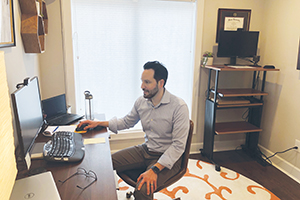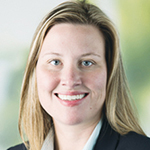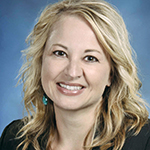Once seen as a temporary fix, remote work could become permanent option for many workers
By LISA EISENHAUER
For tens of thousands of nonclinical staff members at Catholic health systems, the COVID-19 pandemic may have brought a permanent end to work life as they knew it.

Joe Filigno is among the hundreds of workers Bon Secours Mercy Health sent home from the system's main offices in Cincinnati to work remotely beginning in mid-March 2020. Filigno, system director for workforce insight and activation, says he and his team have increased their productivity since making the move to home offices.
Human resources executives from three systems say that associates who were told to work remotely when the pandemic began probably will not be required to return to their former work sites full time. In addition, the on-site work spaces that they will occasionally report to won't have personal offices for most of them.
Greg Till, executive vice president and chief people officer for Providence St. Joseph Health, says his system sent home about 20,000 workers for their own safety as well as the safety of its clinical caregivers when the pandemic started last year. Since then, he and others in the system have been developing a new working model with supporting resources and policies for employees working remotely.

Till
"We've put together, I think, a pretty forward-leaning vision for where and how we want folks to work in the future in a post-COVID world, prioritizing safety, flexibility, collaboration and engagement," Till says.
Under that vision, he says most administrative workers will continue to work in their virtual offices two to four days a week. The other days, they will be in hub locations for work that involves collaboration, community building, and sacred encounters that can't be successfully done virtually. Those sites will have collaborative work spaces as well as drop-in desks with Internet access and computer docks for focused work — configurations similar to those found in business centers in many hotels. Most workers will not have designated offices.
Surveys, pilot programs
Natasha McGraw, vice president of human resources strategic solutions for Bon Secours Mercy Health, says her system has about 6,000 associates who are working remotely. She expects a permanent plan for those workers to be announced before the end of the summer.

McGraw
In recent months, the system has been surveying staffers and managers and testing pilot programs for remote and hybrid work models. McGraw says early evidence has dispelled concern that off-site workers wouldn't get as much done as those working from a system office.
"I think going into this people were questioning whether or not we would be as productive and I think now we've proven that we can be as productive or more productive," she says.
Meanwhile, she adds, work satisfaction among staffers who are remote is "through the roof." A survey found that 84% would like to stay remote and the other 16% would like a hybrid work setup where they are on-site when in-person collaboration is needed. Like the other health systems, Bon Secours Mercy Health is looking at how it could reconfigure its administrative work spaces to provide collaborative work areas rather than private offices.
Finding work-life balance
One of the Bon Secours Mercy Health workers sent home in mid-March 2020 is Joe Filigno, system director for workforce insight and activation. Filigno says that the first months of the transition were challenging to navigate, as he and his wife figured out how to turn their home into a co-
working space and help their son attend virtual kindergarten.

Filigno
He has since come to see the opportunity to work from home as a gift. He has figured out ways to weave family and personal time into his workday. This year, his son is attending a "school pod" with a few other students at the home of a teacher. "When my son gets home, I can run upstairs and get him a snack and say hello to him, and that's amazing," he says. "It's just such a blessing to have that."
Filigno says even though he is putting in more work hours in his remote office than he did at his office in central Cincinnati where he was physically proximate to more than 1,000 colleagues, the flexibility he has been able to build into his work hours makes his job even more enjoyable.
He also says he and his team of about 15 have been more productive working collaboratively from their home offices than they were in the central office. He credits this success to the use of technologies like Zoom and Microsoft Teams that allow them to collaborate as well as to the encouragement from upper management to find a work-life balance that supports their individual needs.
"Health care's known for being pretty hierarchical and fairly conservative, but we've embraced, in the spirit of compassion and understanding, what drives people, what truly makes people able to be their best and I've been truly proud to be part of that here," Filigno says.
Unified, agile, empowered
McGraw says surveys done by Bon Secours Mercy Health have shown that remote workers like "being integrated with their families and their pets." The system's research also has shown that managers need to help remote workers set boundaries on their work time to keep company time from creeping into personal time. One of the ways managers are doing this is by limiting work meetings to normal business hours.
The system also has done what McGraw calls benchmarking studies to see how other employers are addressing the question of remote work. It found that 80% of those that — like Bon Secours Mercy — have been rated as top places to work by business groups have a remote work strategy.
McGraw says that finding indicates that in order to keep and attract top talent, remote work will need to be an option for workers. "It is very important for us, to be able to continue to obtain the talent needed for the future, to continue some remote work strategy," she says.
In McGraw's view, the swiftness with which so many Bon Secours Mercy workers have been able to shift from on-site to remote work shows how agile the system's workforce is.
"Unified, agile and empowered are our main three associate behaviors that we have and expect in our culture and this is definitely being agile," she says. "There is nothing like overnight having to go home and begin working remotely and pivoting everything."
From temporary to permanent
Angela Nguyen, vice president of talent acquisition and colleague relations for Hospital Sisters Health System, says her system initially sent about 1,600 nonclinical workers home during the pandemic. With safety measures and protocols in place, about 900 have been required or wanted to return and the 700 others continue to work remotely by choice.

Nguyen
A HSHS workgroup is developing permanent policies and processes for remote workers, Nguyen says. That workgroup includes executives, managers and representatives from the system's facilities team.
While the policies are still taking shape, Nguyen expects remote work to become a permanent option for many staffers. "For the majority, it's worked very well," she says. "We've seen productivity stay the same and meet standards and in a lot of cases improve."
Like Bon Secours Mercy and Providence, HSHS discussions about remote work policies include the possibility of retooling office spaces so that they mainly provide collaborative work areas and unassigned workstations with Internet access.
Till says that for Providence, having most administrative caregivers — the term the system uses for staff members who don't treat patients or work directly with patients — working off-site might bring some long-term cost savings by allowing it to shrink its office space. But he says that hasn't been a primary consideration in its remote work planning. The goal is to create a future where caregivers can do their best work across virtual and office locations.
Home ergonomics
The system is making investments to make virtual work more functional and comfortable and to make remaining office space more conducive to collaborative work, Till says. Any staffer who works remotely 50% or more of the time is getting a technology stipend that covers wireless Internet access and a technology package that includes a laptop computer, dual monitors, and other equipment to enable a supportive and productive virtual office setup.
The system also is encouraging remote workers to do ergonomic assessments of their work areas to ensure that their home office setups promote health and safety. It is providing office equipment such as desks and chairs if workers need them.
"We've also provided a ton of research and training on how to be a good virtual manager, how to collaborate when you're not in person, and other resources and support for maximizing our caregivers' effectiveness at home — not just their productivity and work output but also their mental health and the wellness that we need to support," Till says.
Wider candidate pool
A benefit the system didn't anticipate but that remote workers have reported is avoiding daily commutes. "It's less wear and tear on our commuters," Till says. "Providence is primarily in major metropolitan hubs like Seattle, Portland and Los Angeles. It takes some of our caregivers an hour to get to work and so this is also adding some additional time for them for work-life balance." Additionally, the virtual work strategy supports Providence's commitment to be carbon negative by 2030.
Managers at all three systems see a wider candidate pool for job openings as a lasting benefit of expanded remote work options. Nguyen says HSHS potentially will be able to recruit workers from across the country and not require them to relocate.
"I think it really broadens our candidate pool and it increases our ability to outreach to a more diverse candidate population, which is really exciting for us," she says.